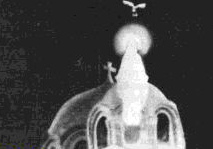Marian apparitions
|
|

Marian apparitions are events in which the Virgin Mary is purported to have supernaturally appeared to one or more persons, typically but not always Christians, often Catholics. They are often given names based on the town in which they were reported, or on the soubriquet which was given to Mary on the occasion of the apparition, or on her reported clothing and hairstyle. They have been interpreted as psychological (pareidolia), and as religious phenomena, occasionally as theophanies. Apparitions sometimes recur at the same site over an extended period of time. Marian apparitions sometimes involve statues or images of Mary; of particular note are weeping statues, witnessed as producing tears.
| Contents |
List of Marian apparitions
- the Basilica di Santa Maria Maggiore in Rome, Italy (352)
- Appearance to Richeldis of Walsingham, Walsingham, England (1061)
- Appearance to St. Dominic, giving him the Rosary (1214)
- Our Lady of Mount Carmel to St. Simon Stock, instituting the scapular - Aylesford, England (1251)
- The Black Madonna - Czestochowa, Poland (1382)
- Our Lady of Guadalupe - Villa Guadalupe (Gustavo A. Madero), Mexico, to Juan Diego, an indigenous farmer, (1531)
- Our Lady of Good Success - Quito, Ecuador (1634)
- Our Lady of the Miraculous Medal, to St. Catherine Labouré, a nun of the Sisters of Charity convent at Rue du Bac, Paris, France (1830)
- Our Lady of La Salette, France, to two cowherder children (1846)
- Our Lady of Lourdes, France, to Bigourdane peasant girl Bernadette Soubirous (1858)
- Pontmain, France (1871)
- Our Lady, Queen of Ireland - Knock, Ireland, to numerous witnesses, along with Saint Joseph and Saint John, (1879)
- Our Lady of Beijing - Beijing, China (1900)
- the weeping statue of Santai, China (1900)
- Our Lady of China - Donglu, China (1900)
- Our Lady of Fatima - Fatima, Portugal, to three shepherd children (1917)
- Beauraing, Belgium, to five schoolchildren (1933)
- Banneux, Belgium, to schoolgirl Mariette Beco (1933)
- Garabandal, Spain, to four country girls (1961-1965)
- Zeitoun, Egypt (1968)
- Sabana Grande, Puerto Rico, to three children (1955)
- Bayside, New York (http://www.roses.org/), to a middle-aged lady (1968-1995)
- Medjugorje, Herzegovina, to five children (1981)
- Hrushiv, Ukraine (1987)
- Litmanová, Slovakia, to two girls (http://www.carpatho-rusyn.org/spirit/limanova.htm) (1990-1995)
- Conyers, Georgia, United States (1990 - 1998)
- St. Johns, Antigua (1994), on a grilled cheese sandwich to Diana Duyser, who sold it on eBay to online casino GoldenPalace.com in November 2004.
- Sydney, Australia (February 2003) [1] (http://www.theage.com.au/articles/2003/02/02/1044122264479.html?oneclick=true) The image is thought to be an optical illusion. [2] (http://www.thesundaymail.news.com.au/common/story_page/0,5936,5963673%255E1702,00.html)
- A highway underpass in Chicago, Illinois, United States (April 2005) [3] (http://www.newsday.com/news/nationworld/nation/wire/sns-ap-underpass-virgin-mary,0,5342249.story?coll=sns-ap-nation-headlines)
Pope_John_Paul_II_Coat_of_Arms.jpg
Papal Marian apparitions
It has been claimed that apparitions were experienced by a number of popes, including Pope Leo XIII in 1884, Pope Pius XII at various stages during his papacy, and Pope John Paul II in 1981, while he recovered from an assassination attempt which occurred on the anniversary of the Fatima apparition. John Paul II's particular devotion to the Blessed Virgin Mary was indicated in his coat of Arms (image, left), which contains a large letter "M" standing under the cross. He also visited many of the most famous alleged apparition sites, notably Fatima, Lourdes, and Knock, and according to some reports may have experienced another visitation on his last visit to Lourdes in 2003.
Possibly the best-known apparition sites are Lourdes and Fatima. Over sixty out of thousands of reported spontaneous healings at the Lourdes Spring have been classified as "inexplicable" by the physicians of the highly critical Lourdes Bureau. The so-called Three Secrets of Fatima received a great deal of attention in the press.
Not all claims of visitations are dealt with favourably by the Catholic Church. For example, the so-called apparitions of Our Lady, Jesus Christ and various saints at Bayside, New York were never condoned or sanctioned in any way, nor were those at Necedah, Wisconsin. The behaviour of the women who claimed these heavenly favours does not compare favourably with the quiet pragmatism of Bernadette Soubirous. Church authorities tend to use Bernadette as a model by which to judge all who purport to have visitations. When the Church does approve a visitation, Catholics are not required to believe in it: it is called "worthy of belief".
Conservative Catholics tend to use claims of Marian visitations to further their political agendas, particularly after the strenuous anti-Communist messages allegedly given by Mary at Fatima. Opponents of abortion rights have attached themselves to the so-called visitations of Medjugorje. Other conservative Catholics have joined with the Vatican in suspecting Medjugorje of being a hoax.
Criticism of Marian apparitions
The Holy See has officially confirmed the apparitions at Guadelupe, Lourdes and Fatima. However, the vast majority of Marian apparitions cannot be confirmed because usually it is only a few people that see her. The exception to this is Zeitoun, where thousands claimed to have seen her over a period of three years.
Marian apparations are criticized by many non-believers as the result of Christian (and particularly Catholic) superstition. This is particularly the case when apparitions occur in mundane locations, such as water-stained plaster;or when they turn out to have a conventional explanation, such as the occasion when an indistinct image of Mary on the side of a church which had attracted crowds of worshippers turned out to be a poster of Boxcar Willie that had been whitewashed over.
Further reading
- Josyp Terelya with Michael H. Brown, Witness to Apparitions and Persecution in the USSR: An Autobiography, Faith Publishing, 1991, trade paperback, 324 pages, ISBN 1877678171
